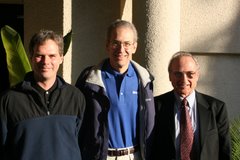ASTM publishes "standards" on many subjects including aquifer test analysis.
ASTM D5912-96 (2004) entitled
Standard Test Method for (Analytical Procedure) Determining Hydraulic Conductivity of an Unconfined Aquifer by Overdamped Well Response to Instantaneous Change in Head (Slug) is one such ASTM standard. You'll spend $32 to obtain a copy of this four-page standard from ASTM, but don't expect to get completely accurate information for your investment.
ASTM D5912-96 (2004) describes a widely used method of slug test analysis devised by Bouwer and Rice (1976). The standard contains an equation (ASTM D5912-96 (2004), p. 2, Equation [2]) used in the Bouwer and Rice method to calculate the parameter
ln(Re/rw) when D (the aquifer thickness) is greater than H (the penetration of the well) as follows:

The
ln(Re/rw) parameter is used in the Bouwer and Rice method to calculate the hydraulic conductivity
K from a slug test.
Unfortunately, the above equation from
ASTM D5912-96 (2004) is incorrect. The correct form of this equation (Bouwer and Rice 1976, p. 425, Equation [8]) is written as follows:

As one can see from a comparison the two foregoing equations, the ASTM version misplaces the term
L/rw and leads to a completely erroneous estimate of
ln(Re/rw).
Am I just nitpicking here? I don't think so. It's hardly unreasonable to expect thorough attention to detail from a publication put forth as a "standard" such as
ASTM D5912-96 (2004). Certainly, the basic equations that are central to such a standard should be checked carefully and published without error. ASTM standards purportedly go through a rigorous review process. Yet
ASTM D5912-96 (2004), adopted in 1996 and subsequently reapproved in 2004, still contains the flawed equation. One is left to wonder how many other "standards" relied upon for aquifer testing contain similar fundamental errors.












